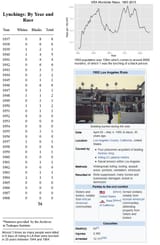Approximately 22 lynchings are documented for Illinois, the last one happening as late as 1943. Most victims were black; at least two white lynchings occurred, one involving a Hardin County farmer hanged by a mob in 1922 for hiring a black farmhand in violation of the area's whites-only prohibitions.
In the town of Lacon, in Marshall County, one George Stewart met his fate for an interracial rape accusation on November 7, 1898. He was accused of attacking Mary O'Brien, the daughter of a foreman at a local mine, while she was walking home from her job as a store clerk. Stewart jumped Ms. O'Brien and tried to hit her over the head with a rock, but only grazed her slightly and she was able to scream for help. The assailant fled but hit her again and knocked her unconscious (she recovered from her injury).
Stewart was identified when his hat blew away on that windy fall evening and was retrieved near the spot where Mary had been attacked. He had recently gotten out of jail after being charged with a robbery in Peoria. When police arrived at his home to arrest him, he made the unwise and self-incriminating remark that he'd lost his hat when it got blown away from the wind.
Around noon the next morning, a mob of 200 people formed around the jail and demanded the prisoner. When the jail guards refused, they broke down the door with a battering ram, seized the jailer's keys, and dragged Stewart outside. He was ordered to confess his crime and did so. He was taken to the spot where the assault took place and hung from a tree there, after remarking that someone should tell his wife he died happy.
In the town of Lacon, in Marshall County, one George Stewart met his fate for an interracial rape accusation on November 7, 1898. He was accused of attacking Mary O'Brien, the daughter of a foreman at a local mine, while she was walking home from her job as a store clerk. Stewart jumped Ms. O'Brien and tried to hit her over the head with a rock, but only grazed her slightly and she was able to scream for help. The assailant fled but hit her again and knocked her unconscious (she recovered from her injury).
Stewart was identified when his hat blew away on that windy fall evening and was retrieved near the spot where Mary had been attacked. He had recently gotten out of jail after being charged with a robbery in Peoria. When police arrived at his home to arrest him, he made the unwise and self-incriminating remark that he'd lost his hat when it got blown away from the wind.
Around noon the next morning, a mob of 200 people formed around the jail and demanded the prisoner. When the jail guards refused, they broke down the door with a battering ram, seized the jailer's keys, and dragged Stewart outside. He was ordered to confess his crime and did so. He was taken to the spot where the assault took place and hung from a tree there, after remarking that someone should tell his wife he died happy.



